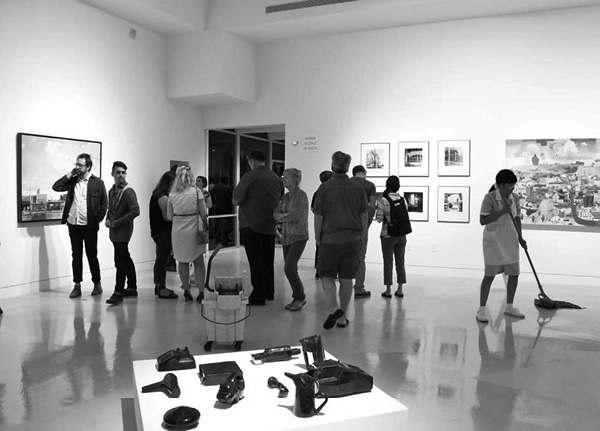
ROSA HERNANDEZ—THE CLEANING LADY
first performed on September 3, 2016
TORRANCE ART MUSEUM, TORRANCE, CA
performed once in 2016
CLAUDIA CANO
San Diego, California
623797693c623797693l623797693a623797693u623797693d623797693i623797693a623797693@623797693c623797693l623797693a623797693u623797693d623797693i623797693a623797693c623797693a623797693n623797693o623797693.623797693c623797693o623797693m
claudiacano.com
ROSA HERNANDEZ—THE CLEANING LADY
CLAUDIA CANO
Finding ways to confront and question the general perception about the roles of working immigrants and their invisibility, I perform as Rosa Hernandez—the cleaning lady—my alter ego. I emerge with the notion of placing underprivileged Latinas in spaces where they usually go unnoticed. The goal is to blur art and life, and engage with an audience while attempting to transform understandings of immigration. Rosa is a typical cleaning lady. She is a non-English speaker, she wears a pink uniform as a symbol of neocolonialism and a scapular as a reminder of how Catholicism was imposed upon the indigenous population. She also has a long pony tail as a symbol of her agricultural roots.
I perform this stereotype to draw attention to the roles played by Latina women in society: the help, the “domestica.” As an immigrant, I find deep connections between two different contexts intertwined with a common ground: the cleaning lady as she exists in Latin America and here in the U.S. In Mexico, underprivileged women from small villages are urged to work in houses as maids to help their families. Latina women in the U.S. do similar work, but the immigrant label is added. The gender roles and social class prevent women of low economic backgrounds from getting access to education and equal opportunities. The performance of Rosa and her actions is an attempt to trigger a process of reflection about the relationship between the viewers and hardworking immigrants like Rosa.
On September 3, 2016, Rosa was invited by the Torrance Art Museum to perform during the opening of the exhibition The Gildless Age. She showed up at 6:30am and started to clean the windows, bathrooms and the perimeter of the museum. When the gallery was crowded, Rosa started to mop the floor of the main gallery. Using her native language Rosa asked people to be careful with the wet floor creating a point of tension among guests. “Is this art?” someone asked.